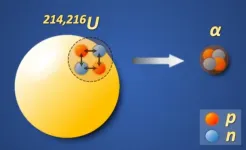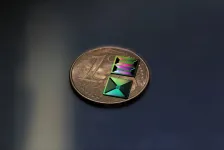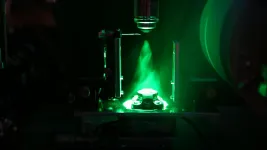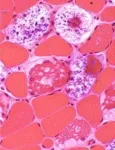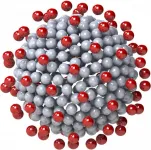A rich marine algal ecosystem 600 million years earlier than previously thought
Biomarker evidence from fossilised algae remains
2021-04-16
(Press-News.org) The first photosynthetic oxygen-producing organisms on Earth were cyanobacteria. Their evolution dramatically changed the Earth allowing oxygen to accumulate into the atmosphere for the first time and further allowing the evolution of oxygen-utilizing organisms including eukaryotes. Eukaryotes include animals, but also algae, a broad group of photosynthetic oxygen-producing organisms that now dominate photosynthesis in the modern oceans. When, however, did algae begin to occupy marine ecosystems and compete with cyanobacteria as important phototrophic organisms?
In a new study Zhang et al use the molecular remains of ancient algae (so-called biomarkers) to show that algae occupied an important role in marine ecosystems 1400 million years ago, some 600 million years earlier than previously recognized.
The specific biomarkers explored by Zhang et al are a group of sterane molecules derived from sterols that are prominent components of cell membranes in eukaryotic organisms. A particular difficulty in analyzing for ancient steranes is that samples are easily contaminated with steranes from other sources. The sources of contamination range from steranes introduced during the sampling, transport and processing of the samples, to geological contamination of steranes as fluids have flow through the rocks.
Zhang et al carefully controlled for each of the sources of contamination and found, as have others, that no steranes were liberated when using standard protocols to extract biomarkers from such ancient rocks, in this case the 1400 million-year-old Xiamaling Formation in North China.
However, Shuichang Zhang, the lead author of the study speculated that "There is some fossil evidence for eukaryotic algae 1400 million years ago, or even earlier, so we wondered whether any steranes in these rocks might be more tightly bound to the kerogens and not easily released during standard biomarker extraction". Therefore, Zhang et al utilized a stepwise heating protocol where samples were slowly heated in gold tubes in 9 steps from 300°C to 490°C. The organic molecules liberated in each of the nine steps were extracted and steranes indicating the presence of both red and green algae were liberated, especially at the higher temperatures.
Zhang continues "Many will be concerned that the steranes we found were a product of some kind of contamination. We were also worried about this, but we ran in parallel samples that have been heated to high temperatures during their geologic history and that, therefore, contained no biomarkers. We found no steranes in these. This means that our protocols were clean, and we are therefore confident that the steranes we found were indigenous to the rock".
It's still not completely clear why the steranes were so tightly bound to the kerogen and not released during standard protocols. But, the findings of Zhang et al. show that both green and red algal groups were present in marine ecosystems by 1400 million years ago. This is 600 million years earlier than evident from previous biomarker studies. This work shows that the red and green algal lineages had certainly evolved by 1400 million years ago, and this should be a useful constraint in timing the overall history of eukaryote evolution. This work also shows that at least some ancient marine ecosystems functioned more similarly to modern ecosystems than previously thought, at least with respect to the types of photosynthetic organisms producing organic matter. This means furthermore that there was sufficient nutrients and oxygen available to drive the presence of algae-containing ecosystems.
Professor Don Canfield, Nordic Center for Earth Evolution, University of Southern Denmark, a co-author on the study adds: "We hope that our study will inspire others to utilize similar techniques to better unravel the full history of eukaryote evolution through geologic time".
INFORMATION:
[Attachments] See images for this press release:

ELSE PRESS RELEASES FROM THIS DATE:
2021-04-16
It is always exciting to find new isotopes with extreme neutron/proton numbers in nuclear physics research. In the region of heavy nuclei, α-decay is one of the pervasive decay modes and plays an essential role in searching for new isotopes. However, even after about a century of studying α-decay, scientists still cannot perfectly describe how the α-particle is formed at the surface of the nucleus before its emission.
In the α-decay process, the α-particle can be regarded not only as two protons plus two neutrons, but also as two proton-neutron pairs. Although previous studies have proved the importance of the pairing forces between the identical nucleons, it remains unclear whether ...
2021-04-16
Older adults are more willing to make an effort to help others than younger adults, according to new research from the University of Birmingham.
The study, led by researchers in the University's School of Psychology, is the first to show how effortful 'prosocial' behaviour - intended to benefit others - changes as people get older. In particular, it focused on people's willingness to exert physical effort, rather than to give money or time, since attitudes to both these are known to change with age. The research results are published in Psychological Science.
In the study, the research team tested a group of 95 adults aged between 18 and 36, and a group of 92 adults aged 55-85. Each participant made 150 choices about whether or not to grip a handheld ...
2021-04-16
WASHINGTON, April 16, 2021 -- Early in the COVID-19 pandemic, doctors recognized that patients who developed a "cytokine storm" -- a surge of pro-inflammatory immune proteins -- were often the sickest and at highest risk of dying. But a cytokine storm can also occur in other illnesses, such as influenza. Today, scientists report preliminary results on a sweat sensor that acts as an early warning system for an impending cytokine storm, which could help doctors more effectively treat patients.
The researchers will present their results today at the spring meeting of the American Chemical Society (ACS). ACS Spring 2021 is being held online April 5-30. Live sessions will be hosted April 5-16, ...
2021-04-16
Encoding information into light, and transmitting it through optical fibers lies at the core of optical communications. With an incredibly low loss of 0.2 dB/km, optical fibers made from silica have laid the foundations of today's global telecommunication networks and our information society.
Such ultralow optical loss is equally essential for integrated photonics, which enable the synthesis, processing and detection of optical signals using on-chip waveguides. Today, a number of innovative technologies are based on integrated photonics, including semiconductor ...
2021-04-16
Researchers at Aalto University have developed a new device for spintronics. The results have been published in the journal Nature Communications, and mark a step towards the goal of using spintronics to make computer chips and devices for data processing and communication technology that are small and powerful.
Traditional electronics uses electrical charge to carry out computations that power most of our day-to-day technology. However, engineers are unable to make electronics do calculations faster, as moving charge creates heat, and we're at the ...
2021-04-16
Vitamin D deficiency may impair muscle function due to a reduction in energy production in the muscles, according to a mouse study published in the Journal of Endocrinology. Vitamin D deficient mice were found to have impaired muscle mitochondrial function, which may have implications for muscle function, performance and recovery. This may suggest that preventing vitamin D deficiency in older adults could help maintain better muscle strength and function and reduce age related muscle deterioration, but further studies are needed to confirm this.
Vitamin D is a hormone well known to be important for maintaining bone health and preventing ...
2021-04-16
Douglas Wilbur '14, a visiting Ph.D. scholar in the Department of Communication at UTSA, has published a study that shows how researchers can craft message campaigns to protect individuals from adopting extremist views.
According to his research, when people are explicitly told that they are free to accept or reject propagandistic claims, the likelihood of choosing a moderate view increases. This was a result of a survey of attitudes that tested counter-propaganda strategies, which stressed a person's autonomy, and then measured sentiments after exposure.
The study was ...
2021-04-16
Sophia Antipolis - 16 April 2021: Working hours that deviate from an individual's natural body clock are associated with greater cardiovascular risk, according to research presented at ESC Preventive Cardiology 2021, an online scientific congress of the European Society of Cardiology (ESC).1
"Our study found that for each hour the work schedule was out of sync with an employee's body clock, the risk of heart disease got worse," said study author Dr. Sara Gamboa Madeira of the University of Lisbon, Portugal.
At least 20% of European employees work atypical hours or shifts,2 and growing scientific evidence associates these with deleterious cardiovascular outcomes.3 A number of explanations ...
2021-04-16
Rare diseases are sometimes the most difficult to treat because of a lack of research and fewer participants to study.
An example would be those who have Pompe disease, a genetic condition when a body can't make a protein that breaks down a complex sugar, called glycogen, for energy. Too much glycogen builds up and damages muscles and organs. The disease causes muscle weakness and trouble breathing and can affect the heart and muscles.
In the case of Pompe disease, however, University of Cincinnati researchers have found a newer, more effective treatment for the rare condition that could become the new standard of care.
Hani Kushlaf, MD, an associate professor in both the Department of Neurology and Rehabilitation Medicine and the ...
2021-04-16
COVID-19 needs no introduction. Last year, the disease, which is caused by the virus SARS-CoV-2, reached every continent across the globe. By the end of March 2021, there had been an estimated 128 million cases recorded with almost three million of these being fatal. As scientists' race to develop vaccines and politicians coordinate their distribution, fundamental research on what makes this virus so successful is also being carried out.
Within the Mathematics, Mechanics, and Materials Unit at the Okinawa Institute of Science and Technology Graduate University (OIST), postdoctoral researcher, Dr. Vikash Chaurasia, and Professor Eliot Fried have been using energy minimization techniques to look at charged proteins on biological particles. Previously they researched ...
LAST 30 PRESS RELEASES:
[Press-News.org] A rich marine algal ecosystem 600 million years earlier than previously thought
Biomarker evidence from fossilised algae remains

